Shiming Ge
COST: Contrastive One-Stage Transformer for Vision-Language Small Object Tracking
Apr 02, 2025Abstract:Transformer has recently demonstrated great potential in improving vision-language (VL) tracking algorithms. However, most of the existing VL trackers rely on carefully designed mechanisms to perform the multi-stage multi-modal fusion. Additionally, direct multi-modal fusion without alignment ignores distribution discrepancy between modalities in feature space, potentially leading to suboptimal representations. In this work, we propose COST, a contrastive one-stage transformer fusion framework for VL tracking, aiming to learn semantically consistent and unified VL representations. Specifically, we introduce a contrastive alignment strategy that maximizes mutual information (MI) between a video and its corresponding language description. This enables effective cross-modal alignment, yielding semantically consistent features in the representation space. By leveraging a visual-linguistic transformer, we establish an efficient multi-modal fusion and reasoning mechanism, empirically demonstrating that a simple stack of transformer encoders effectively enables unified VL representations. Moreover, we contribute a newly collected VL tracking benchmark dataset for small object tracking, named VL-SOT500, with bounding boxes and language descriptions. Our dataset comprises two challenging subsets, VL-SOT230 and VL-SOT270, dedicated to evaluating generic and high-speed small object tracking, respectively. Small object tracking is notoriously challenging due to weak appearance and limited features, and this dataset is, to the best of our knowledge, the first to explore the usage of language cues to enhance visual representation for small object tracking. Extensive experiments demonstrate that COST achieves state-of-the-art performance on five existing VL tracking datasets, as well as on our proposed VL-SOT500 dataset. Source codes and dataset will be made publicly available.
Efficient Low-Resolution Face Recognition via Bridge Distillation
Sep 18, 2024Abstract:Face recognition in the wild is now advancing towards light-weight models, fast inference speed and resolution-adapted capability. In this paper, we propose a bridge distillation approach to turn a complex face model pretrained on private high-resolution faces into a light-weight one for low-resolution face recognition. In our approach, such a cross-dataset resolution-adapted knowledge transfer problem is solved via two-step distillation. In the first step, we conduct cross-dataset distillation to transfer the prior knowledge from private high-resolution faces to public high-resolution faces and generate compact and discriminative features. In the second step, the resolution-adapted distillation is conducted to further transfer the prior knowledge to synthetic low-resolution faces via multi-task learning. By learning low-resolution face representations and mimicking the adapted high-resolution knowledge, a light-weight student model can be constructed with high efficiency and promising accuracy in recognizing low-resolution faces. Experimental results show that the student model performs impressively in recognizing low-resolution faces with only 0.21M parameters and 0.057MB memory. Meanwhile, its speed reaches up to 14,705, ~934 and 763 faces per second on GPU, CPU and mobile phone, respectively.
* This paper is published in IEEE TIP 2020
Distilling Channels for Efficient Deep Tracking
Sep 18, 2024
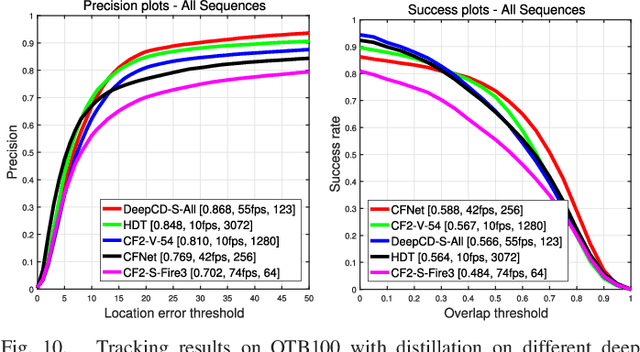


Abstract:Deep trackers have proven success in visual tracking. Typically, these trackers employ optimally pre-trained deep networks to represent all diverse objects with multi-channel features from some fixed layers. The deep networks employed are usually trained to extract rich knowledge from massive data used in object classification and so they are capable to represent generic objects very well. However, these networks are too complex to represent a specific moving object, leading to poor generalization as well as high computational and memory costs. This paper presents a novel and general framework termed channel distillation to facilitate deep trackers. To validate the effectiveness of channel distillation, we take discriminative correlation filter (DCF) and ECO for example. We demonstrate that an integrated formulation can turn feature compression, response map generation, and model update into a unified energy minimization problem to adaptively select informative feature channels that improve the efficacy of tracking moving objects on the fly. Channel distillation can accurately extract good channels, alleviating the influence of noisy channels and generally reducing the number of channels, as well as adaptively generalizing to different channels and networks. The resulting deep tracker is accurate, fast, and has low memory requirements. Extensive experimental evaluations on popular benchmarks clearly demonstrate the effectiveness and generalizability of our framework.
Distilling Generative-Discriminative Representations for Very Low-Resolution Face Recognition
Sep 10, 2024



Abstract:Very low-resolution face recognition is challenging due to the serious loss of informative facial details in resolution degradation. In this paper, we propose a generative-discriminative representation distillation approach that combines generative representation with cross-resolution aligned knowledge distillation. This approach facilitates very low-resolution face recognition by jointly distilling generative and discriminative models via two distillation modules. Firstly, the generative representation distillation takes the encoder of a diffusion model pretrained for face super-resolution as the generative teacher to supervise the learning of the student backbone via feature regression, and then freezes the student backbone. After that, the discriminative representation distillation further considers a pretrained face recognizer as the discriminative teacher to supervise the learning of the student head via cross-resolution relational contrastive distillation. In this way, the general backbone representation can be transformed into discriminative head representation, leading to a robust and discriminative student model for very low-resolution face recognition. Our approach improves the recovery of the missing details in very low-resolution faces and achieves better knowledge transfer. Extensive experiments on face datasets demonstrate that our approach enhances the recognition accuracy of very low-resolution faces, showcasing its effectiveness and adaptability.
Look One and More: Distilling Hybrid Order Relational Knowledge for Cross-Resolution Image Recognition
Sep 09, 2024



Abstract:In spite of great success in many image recognition tasks achieved by recent deep models, directly applying them to recognize low-resolution images may suffer from low accuracy due to the missing of informative details during resolution degradation. However, these images are still recognizable for subjects who are familiar with the corresponding high-resolution ones. Inspired by that, we propose a teacher-student learning approach to facilitate low-resolution image recognition via hybrid order relational knowledge distillation. The approach refers to three streams: the teacher stream is pretrained to recognize high-resolution images in high accuracy, the student stream is learned to identify low-resolution images by mimicking the teacher's behaviors, and the extra assistant stream is introduced as bridge to help knowledge transfer across the teacher to the student. To extract sufficient knowledge for reducing the loss in accuracy, the learning of student is supervised with multiple losses, which preserves the similarities in various order relational structures. In this way, the capability of recovering missing details of familiar low-resolution images can be effectively enhanced, leading to a better knowledge transfer. Extensive experiments on metric learning, low-resolution image classification and low-resolution face recognition tasks show the effectiveness of our approach, while taking reduced models.
Low-Resolution Object Recognition with Cross-Resolution Relational Contrastive Distillation
Sep 04, 2024Abstract:Recognizing objects in low-resolution images is a challenging task due to the lack of informative details. Recent studies have shown that knowledge distillation approaches can effectively transfer knowledge from a high-resolution teacher model to a low-resolution student model by aligning cross-resolution representations. However, these approaches still face limitations in adapting to the situation where the recognized objects exhibit significant representation discrepancies between training and testing images. In this study, we propose a cross-resolution relational contrastive distillation approach to facilitate low-resolution object recognition. Our approach enables the student model to mimic the behavior of a well-trained teacher model which delivers high accuracy in identifying high-resolution objects. To extract sufficient knowledge, the student learning is supervised with contrastive relational distillation loss, which preserves the similarities in various relational structures in contrastive representation space. In this manner, the capability of recovering missing details of familiar low-resolution objects can be effectively enhanced, leading to a better knowledge transfer. Extensive experiments on low-resolution object classification and low-resolution face recognition clearly demonstrate the effectiveness and adaptability of our approach.
Learning Privacy-Preserving Student Networks via Discriminative-Generative Distillation
Sep 04, 2024Abstract:While deep models have proved successful in learning rich knowledge from massive well-annotated data, they may pose a privacy leakage risk in practical deployment. It is necessary to find an effective trade-off between high utility and strong privacy. In this work, we propose a discriminative-generative distillation approach to learn privacy-preserving deep models. Our key idea is taking models as bridge to distill knowledge from private data and then transfer it to learn a student network via two streams. First, discriminative stream trains a baseline classifier on private data and an ensemble of teachers on multiple disjoint private subsets, respectively. Then, generative stream takes the classifier as a fixed discriminator and trains a generator in a data-free manner. After that, the generator is used to generate massive synthetic data which are further applied to train a variational autoencoder (VAE). Among these synthetic data, a few of them are fed into the teacher ensemble to query labels via differentially private aggregation, while most of them are embedded to the trained VAE for reconstructing synthetic data. Finally, a semi-supervised student learning is performed to simultaneously handle two tasks: knowledge transfer from the teachers with distillation on few privately labeled synthetic data, and knowledge enhancement with tangent-normal adversarial regularization on many triples of reconstructed synthetic data. In this way, our approach can control query cost over private data and mitigate accuracy degradation in a unified manner, leading to a privacy-preserving student model. Extensive experiments and analysis clearly show the effectiveness of the proposed approach.
Low-Resolution Face Recognition via Adaptable Instance-Relation Distillation
Sep 03, 2024Abstract:Low-resolution face recognition is a challenging task due to the missing of informative details. Recent approaches based on knowledge distillation have proven that high-resolution clues can well guide low-resolution face recognition via proper knowledge transfer. However, due to the distribution difference between training and testing faces, the learned models often suffer from poor adaptability. To address that, we split the knowledge transfer process into distillation and adaptation steps, and propose an adaptable instance-relation distillation approach to facilitate low-resolution face recognition. In the approach, the student distills knowledge from high-resolution teacher in both instance level and relation level, providing sufficient cross-resolution knowledge transfer. Then, the learned student can be adaptable to recognize low-resolution faces with adaptive batch normalization in inference. In this manner, the capability of recovering missing details of familiar low-resolution faces can be effectively enhanced, leading to a better knowledge transfer. Extensive experiments on low-resolution face recognition clearly demonstrate the effectiveness and adaptability of our approach.
Learning Differentially Private Diffusion Models via Stochastic Adversarial Distillation
Aug 27, 2024Abstract:While the success of deep learning relies on large amounts of training datasets, data is often limited in privacy-sensitive domains. To address this challenge, generative model learning with differential privacy has emerged as a solution to train private generative models for desensitized data generation. However, the quality of the images generated by existing methods is limited due to the complexity of modeling data distribution. We build on the success of diffusion models and introduce DP-SAD, which trains a private diffusion model by a stochastic adversarial distillation method. Specifically, we first train a diffusion model as a teacher and then train a student by distillation, in which we achieve differential privacy by adding noise to the gradients from other models to the student. For better generation quality, we introduce a discriminator to distinguish whether an image is from the teacher or the student, which forms the adversarial training. Extensive experiments and analysis clearly demonstrate the effectiveness of our proposed method.
Learning Natural Consistency Representation for Face Forgery Video Detection
Jul 15, 2024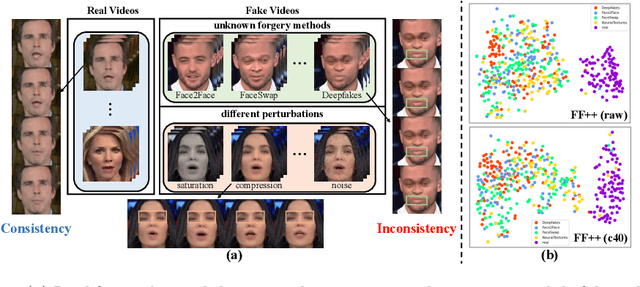
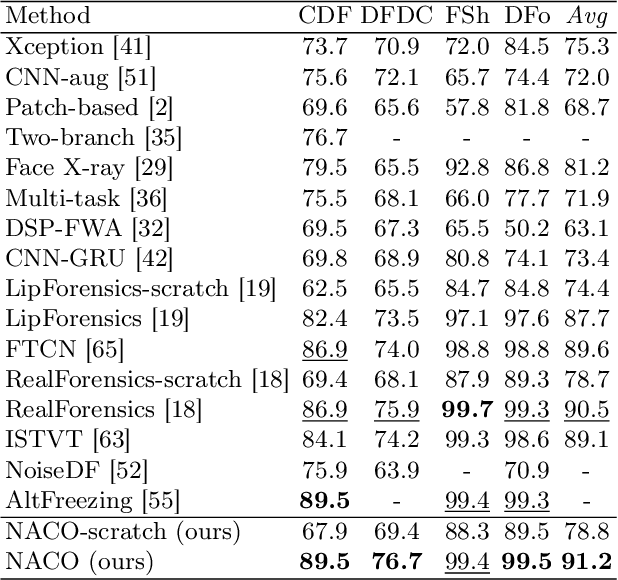
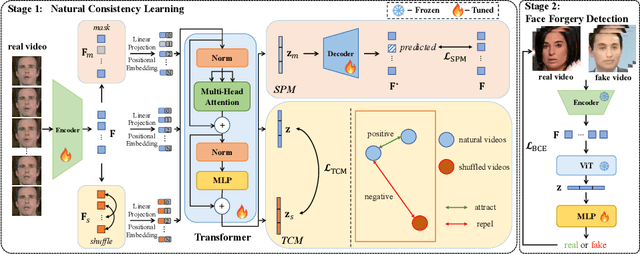
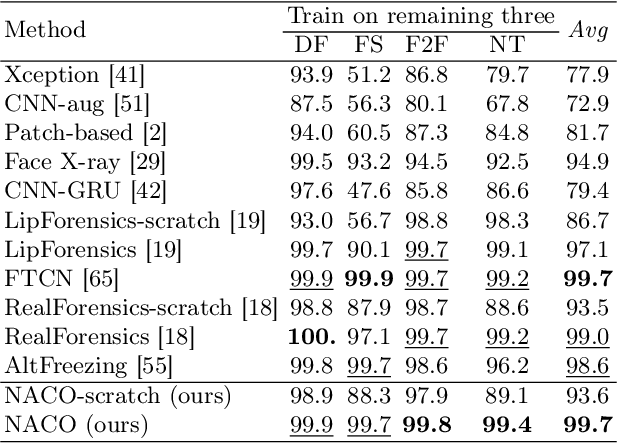
Abstract:Face Forgery videos have elicited critical social public concerns and various detectors have been proposed. However, fully-supervised detectors may lead to easily overfitting to specific forgery methods or videos, and existing self-supervised detectors are strict on auxiliary tasks, such as requiring audio or multi-modalities, leading to limited generalization and robustness. In this paper, we examine whether we can address this issue by leveraging visual-only real face videos. To this end, we propose to learn the Natural Consistency representation (NACO) of real face videos in a self-supervised manner, which is inspired by the observation that fake videos struggle to maintain the natural spatiotemporal consistency even under unknown forgery methods and different perturbations. Our NACO first extracts spatial features of each frame by CNNs then integrates them into Transformer to learn the long-range spatiotemporal representation, leveraging the advantages of CNNs and Transformer on local spatial receptive field and long-term memory respectively. Furthermore, a Spatial Predictive Module~(SPM) and a Temporal Contrastive Module~(TCM) are introduced to enhance the natural consistency representation learning. The SPM aims to predict random masked spatial features from spatiotemporal representation, and the TCM regularizes the latent distance of spatiotemporal representation by shuffling the natural order to disturb the consistency, which could both force our NACO more sensitive to the natural spatiotemporal consistency. After the representation learning stage, a MLP head is fine-tuned to perform the usual forgery video classification task. Extensive experiments show that our method outperforms other state-of-the-art competitors with impressive generalization and robustness.
 Add to Chrome
Add to Chrome Add to Firefox
Add to Firefox Add to Edge
Add to Edge